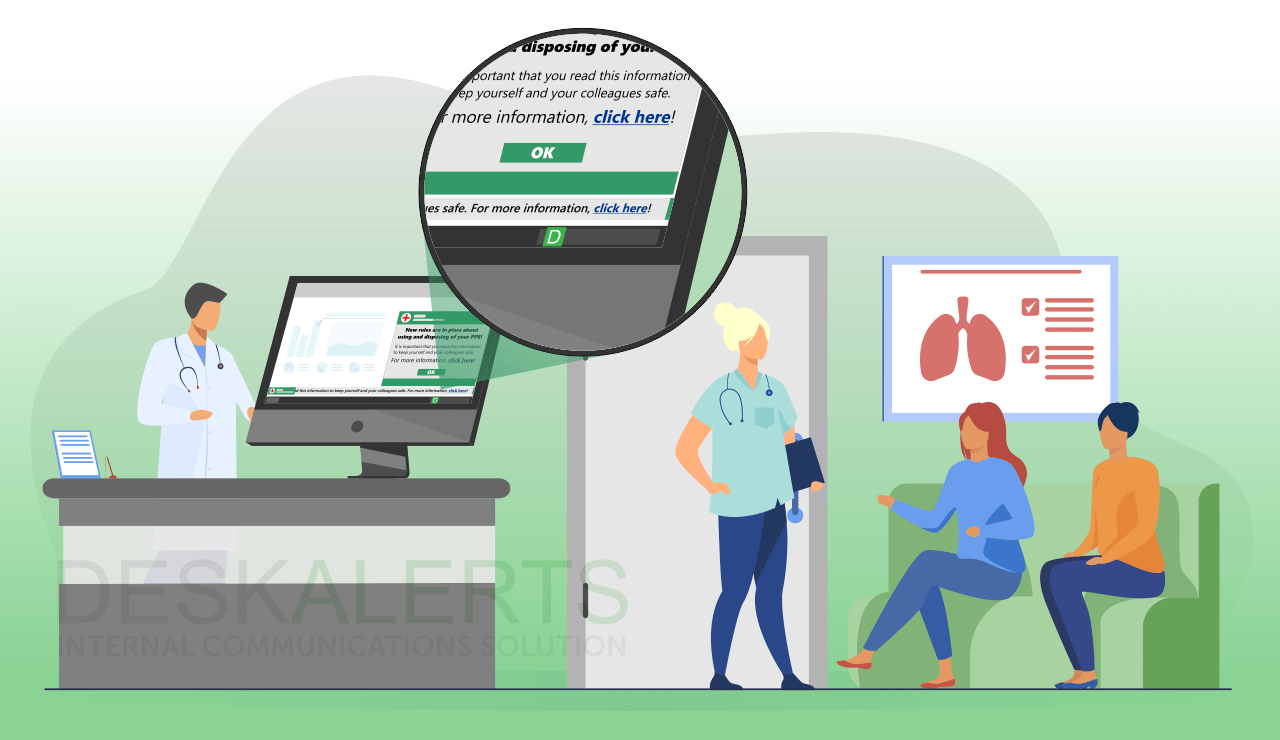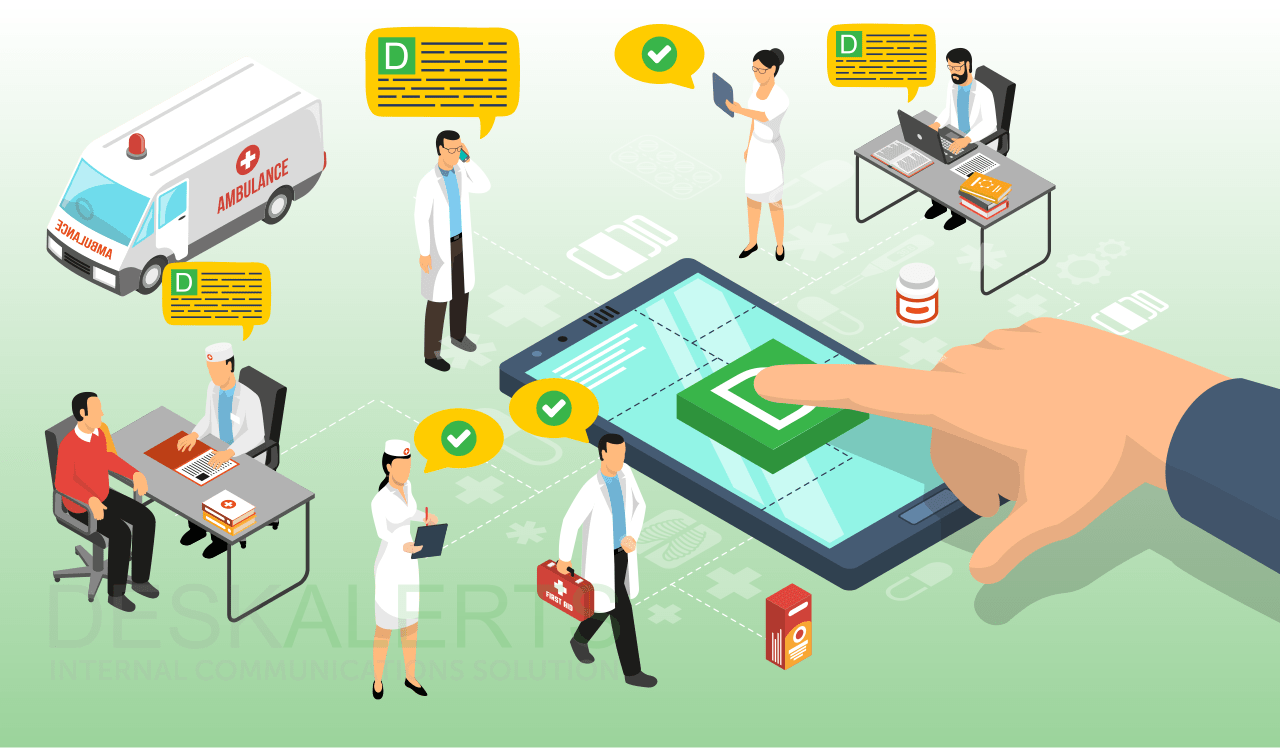
Hospital communication systems like DeskAlerts improve efficiency and patient care by enabling instant information sharing. From coordinating emergency codes to updating staff on critical changes, these systems reduce errors and ensure healthcare providers stay informed.
The healthcare sector has undergone significant advancements in hospital communication systems and information management in recent years. Hospitals are beginning to embrace digital smart technology and digital tools to drive efficiencies and keep up with modern ways of doing business.
This transformation has led to the increased adoption of mobile-first communication strategies, telemedicine platforms, and healthcare communication platforms like alerts software. However, not all hospitals and healthcare organizations are this advanced in their journey.
Table of contents
What Are Hospital Communication Systems?
What Are Common Communication Systems in Healthcare?
Why Good Communication Is Essential in Healthcare
New Trends Emerging In Healthcare Communication Systems
Benefits of Mobile-First Communication and Alerts Software
What Are Hospital Communication Systems?
Hospital communications systems are software, technologies and other processes used by hospitals to send and receive information among their workforces. This includes with both medical and administrative staff, different work teams, management and more.
The overall aim of these systems is to enhance and improve patient care and ensure the smooth running of hospital operations by facilitating better information flow, reducing errors and streamlining workflows.
Read also: "The Importance of Internal Communications in Healthcare".
What Are Common Communication Systems in Healthcare?
There are numerous different types of hospital communication systems in use within healthcare organizations. Some of the most common include:
- Electronic health records (EHRs)
- Emails
- Nurse call systems
- Intranets
- Internal messaging platforms
- Nurse call systems
- Public address and intercom systems
- Pagers
- Telehealth platforms
- Staff messaging tools
Why Good Communication Is Essential in Healthcare
Hospitals and healthcare organizations operate in high-stakes environments where timeliness and accuracy of secure communication in healthcare can literally mean the difference between life and death, or have other serious consequences. It is therefore essential to have good communication in healthcare to ensure that patients receive safe, high-quality, and effective care.
Numerous studies have shown a link between improved communication in healthcare and safer work environments for staff, a decrease in adverse events, and better patient outcomes.
Research also shows that when there is strong communication between healthcare workers, there are better working relationships and improved job satisfaction.
The following can be achieved:
- Prevention of medical errors and adverse events
- Increased trust and rapport among staff, leading to better patient engagement and outcomes
- Better facilitation of accurate diagnosis and treatment
- Improved management of patient expectations and concerns
- A reduction in healthcare costs by avoiding unnecessary tests and procedures
- Enhancements to patient satisfaction and experience
- Improved morale among healthcare workers
- Improved compliance with legal and regulatory requirements and obligations
- Productive working relationships can be established
- Promotion of a culture of transparency and accountability.
Want to see how healthcare teams like yours are solving communication challenges?
Download our free guide: 8 Real-World Use Cases: How Healthcare Teams Communicate Faster and Safer with DeskAlerts.

You'll discover how hospitals:
- Enhance shift coordination
- Streamline emergency responses
- Ensure compliance updates
- Boost operational efficiency
Learn what’s working in real hospitals and get actionable ideas to improve internal communication in your organization.
Trending In Healthcare Communication Systems
As technology rapidly advances, hospitals and healthcare organizations need to continuously keep up. Some of the internal communication trends emerging in 2025 are:
- Digital health technologies and digitization
This is an all-encompassing term to describe the way that a number of different digital systems have rapidly changed and are being integrated within healthcare organizations, revolutionizing their processes and systems.
New digital health technologies that affect hospital communication systems include telehealth platforms, patient portals and mobile health apps that are used by patients as well as staff. Many of these have internal hospital communications uses within organizations and aren’t just patient-facing.
- Artificial intelligence (AI)
The rise of artificial intelligence has been a game-changer for many different sectors, with many different tasks. It has the ability to affect internal communications in healthcare and can potentially help to improve certain aspects of it.
Examples of how this technology can be used include by deploying AI-powered chatbots and virtual assistants to help different teams access information, streamlining workflows, reducing errors and improving response times, personalizing the employee experience, providing staff with predictive analysis so they can make data-driven decisions, provision of virtual training and development and helping to reduce burnout and stress by freeing staff up from certain administrative burdens.
- Collaboration tools
Like teams in other industries, healthcare teams are increasingly adopting the use of collaboration tools and platforms as part of their work. These tools help them to enhance communication, coordination and care delivery.
These tools don’t just help work teams to communicate among themselves: they help to break down information silos and encourage interdisciplinary collaboration so that doctors, nurses, pharmacists, administrators, allied health professionals and other teams within the hospital can easily exchange information.
- Mobile phone apps
Pagers are slowly but surely being made redundant in many healthcare organizations. While cellphone coverage in hospital buildings has often been problematic, the use of wifi has meant that mobile phone apps are becoming a viable solution to improving hospital communication. Staff usually have their personal mobile phones with them and are able to use a variety of mobile apps that communicate information with them.
MOBILE ALERT APP FOR BUSINESS
- Smart badges
A smart badge is a wearable device that provides professionals in hospitals a way to communicate in a hands-free manner. Generally powered by bluetooth they have similar functionality to mobile phones and can be used for hands-free voice calls or voice-to-text messaging while staff have their hands full with other activities.
They can also be used for staff to quickly track down other team members so they no longer have to rely on pagers, public address systems or intercoms. Additional benefits include better hand hygiene and improved contact tracing when staff come into contact with a contagious pathogen, such as COVID-19 or bird flu.
- Digital Transformation
The healthcare sector has been notoriously slow to keep up with technological change when it comes to communication systems and information management. Pagers, fax machines and paper-based records are just some examples that easily spring to mind as still being common in healthcare when seemingly the rest of the world has moved on from them.
Technology is not slowing down. In fact, the COVID-19 pandemic has seen a need for outdated systems to be replaced by more efficient ones. Hospitals are finally needing to embrace digital smart technology and digital tools to drive efficiencies and keep up with ways of doing business that exist across other sectors.
By embracing digital transformation, hospitals can expect to optimize their resource allocation which improves performance and reduces waste.
Enhanced data analytics from digital transformation also ensure that hospitals can derive actionable insights so that they can continuously drive quality improvement.
- Mobile-First Communication and Alerts Software
Mobile-first communication is an approach where organizations recognize that most people have and rely on cellphones to get information, and prioritize their communications accordingly to reflect that.
In practice, this means mobile shouldn’t be considered as an afterthought when communicating with healthcare staff.
In terms of internal communication within a hospital, a mobile-first communication system would center around specific communication channels that can be sent via mobile (messenger apps, employee collaboration tools, SMS, email, intranet content, push notifications, alerts, etc). Content that is produced would be tailored for these channels - for example image-rich, video content, short amounts of text etc.
A mobile-first hospital communication approach makes it easier than ever before for colleagues to access and share information and communicate with each other, and receive critical notifications and alerts. It facilitates better two-way communication such as video conferencing, text messages, voice calls, sharing photos and more that traditional communication channels don’t always offer in the one place.
This approach is also becoming increasingly necessary as workforces have become remote or flexible in their work arrangements. It means that healthcare staff can stay connected with their workplace and be productive, no matter where they are working.
STAY CONNECTED ON THE GO WITH SMS ALERTS
Alerts software is a communication tool that can help hospitals to facilitate a mobile-first communication approach. The software will send alerts and notifications to mobile devices (smartphones and tablets) to keep healthcare workers informed.
- Telemedicine
Telemedicine is a way to use technology so that healthcare services can be provided to patients remotely. Patients are able to receive consultations, advice, education and even prescriptions and referrals without physically attending a healthcare facility. It also helps healthcare professionals to be able to remotely monitor their patients’ progress, and is particularly beneficial for patients who have mobility issues, are unwell or live in remote areas who find it difficult to attend an appointment in person.
There are benefits for healthcare providers as well as patients, however. Increased use of telemedicine can provide greater flexibility and work-life balance for healthcare workers, reducing their travel time and expenses.
Telemedicine platforms can also be used for hospital communication so that clinicians can work collaboratively and share information, or engage in professional development opportunities that would otherwise be unrealistic because of travel and budgets.
Benefits of Mobile-First Communication and Alerts Software

There are several benefits to hospitals in adopting a mobile-first communication strategy that uses alerts software:
- Ability to reach and connect with everyone in the organization. A mobile platform provides hospitals with a way to connect colleagues across the spectrum - from administration and maintenance personnel through to surgeons and other specialists.
- It facilitates real-time communication. Forget emails, or pagers, or memos - this information can date quickly. Mobile-first hospital communication systems make it easy for information sharing to occur in real time which ultimately means a more efficient workplace.
- Removal of information silos. By moving to a centralized platform, healthcare organizations can eliminate communication silos. Departments and teams can work more seamlessly and collaborate more easily, which leads to better coordination and improved outcomes for patients.
- Makes it harder for information to be ignored. When you use an alert system like DeskAlerts as part of your mobile-first communications approach you will ensure that important information is always delivered to employees’ devices in a way they can’t ignore, cutting through the digital “noise” and unlike emails or intranets, you can be guaranteed of a 100% read rate.
Want to explore real examples of how hospitals use DeskAlerts?
Our free guide, 8 Real-World Use Case,s shows how leading healthcare teams are transforming communication:
- Better shift handovers
- Faster response during emergencies
- Clear compliance updates
- Real-time alerts your staff won’t miss

By leveraging these hospital communication systems, hospitals can improve internal communication, optimize resource allocation, derive actionable insights, and continuously drive quality improvement within their organizations. Get in touch with our team of experts today for a free demo of how you can use DeskAlerts in a mobile-first communications approach in your hospital.
 Caroline Duncan
Caroline Duncan









